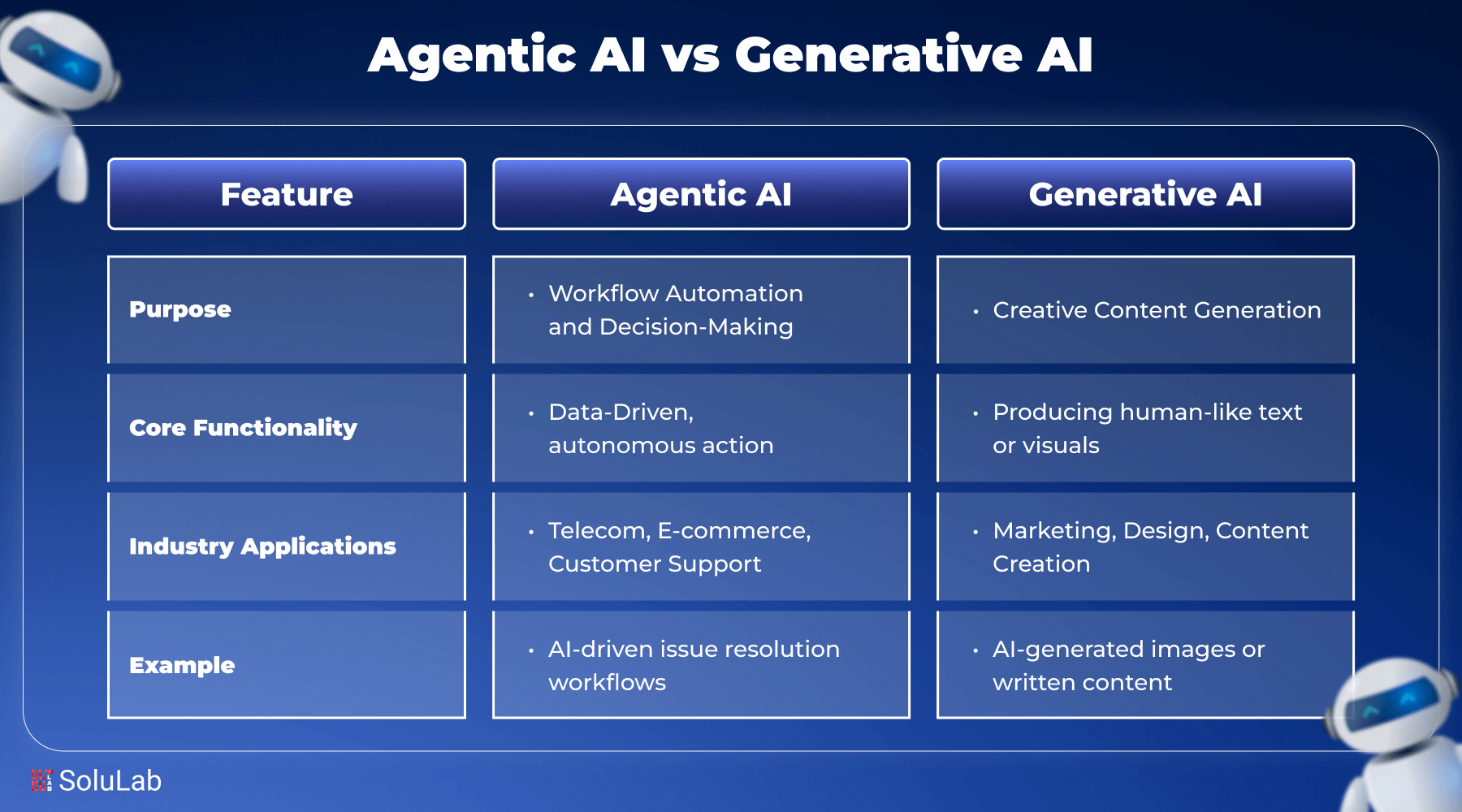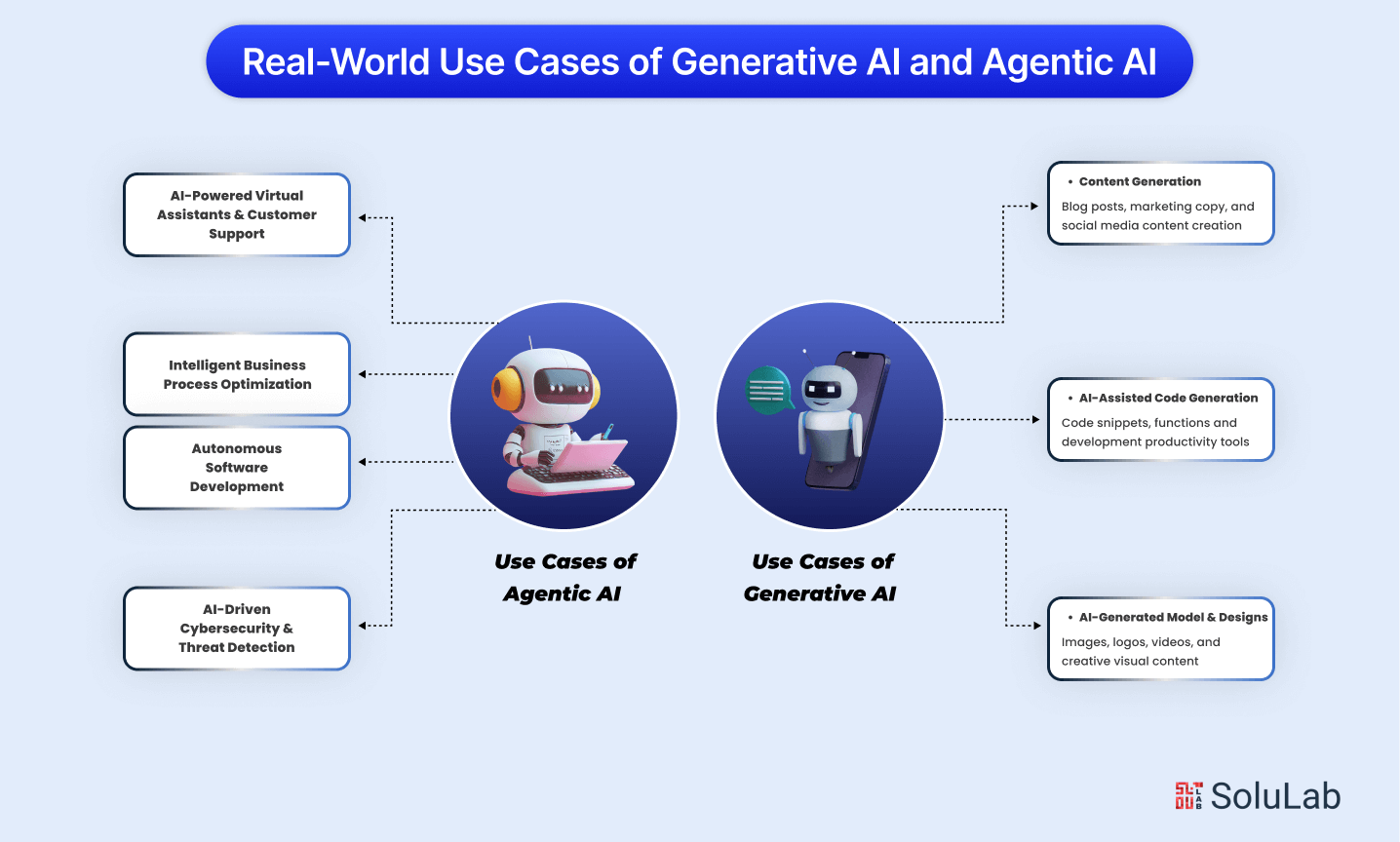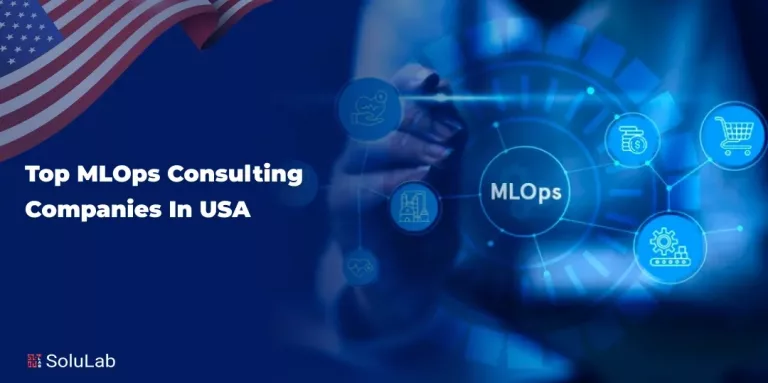
Ever wondered what sets Agentic AI apart from Generative AI? Both sound futuristic and powerful, but they serve very different purposes, and knowing the difference can change how you use them, whether it’s getting a movie recommendation, chatting with an AI-powered assistant, or enjoying AI-generated content.
Both use advanced machine learning and deep learning, but they differ a lot in how they function, make decisions, and where they’re applied.
So, what makes them different? Knowing this is key for businesses and developers aiming to improve automation, boost efficiency, and build smarter AI solutions. Let’s take a closer look at generative AI vs agentic AI!
What is Agentic AI?
Agentic AI is AI that can act on its own, make decisions, and carry out tasks without needing you to guide every step. It’s like having a smart assistant that listens and takes initiative, kind of like a helpful teammate who knows when to jump in and get things done. Agentic AI often works as part of multi-agent systems in AI, where multiple intelligent agents collaborate to handle complex tasks efficiently.
However, the global Generative AI market was valued at $43.87 billion in 2023 and is projected to reach $967.65 billion by 2032, growing at a CAGR of 39.6%. Here are the strategic advantages of Agentic AI:
- Autonomous Decision-Making: It can figure out the best way to solve a problem on its own.
- Goal-Oriented Behavior: It stays focused on what you want and works actively to achieve those goals.
- Learning & Adaptation: It learns from experience and improves its actions over time.
- Multi-Step Planning: It can plan and handle complex tasks that need several steps.
What is Generative AI?
Generative AI is a type of artificial intelligence that can create new content all on its own, like writing text, making images, or even composing music. Instead of just analyzing data, it generates something fresh based on what it’s learned.
Moreover, the Agentic AI market is expected to grow from $4.26 billion in 2024 to $41.32 billion by 2030, with a CAGR of 41.48%. Here are a few standout features:
1. Creative Content Generation: It can write stories, design graphics, or produce music without human input.
2. Learning from Data: It gets smarter by studying tons of examples to mimic styles or patterns.
3. Versatility: From chatbots to art tools, it’s used in tons of different fields.
4. Real-time Interaction: It can respond instantly, making conversations or content creation feel natural.
Agentic AI vs Generative AI: Key Differences
Let’s break down the key differences between Agentic AI and Generative AI. Understanding these differences helps you see where each shines, especially in real-world applications like Agentic AI in different industries.
| Parameters | Agentic AI | Generative AI |
| Purpose | Designed to autonomously perform tasks, make decisions, and solve complex problems. Source | Creates new content like text, images, or code based on learned patterns from training data. Source |
| Interaction Style | Proactive and autonomous, initiating actions and adapting to environments. Source | Reactive, responding to user inputs or prompts to generate output. Source |
| Applications | Agentic AI use cases include autonomous software development, cybersecurity, virtual assistants, and business process optimization. | Used for content generation, code writing, media creation, and conversational AI like chatbots. Source |
| Example Tools | AI-powered assistants, self-driving cars | OpenAI’s GPT series, DALL·E, Midjourney, and GitHub Copilot for generating content and code. |
| Learning Approach | Continuous learning and adaptation from real-time data and environment feedback. | Learns from large datasets during training but typically doesn’t adapt autonomously after deployment. |
| Strengths | High autonomy, real-time decision-making, adaptability across industries, and handling complex workflows. Source | Creativity, rapid content generation, versatility in media types, and ease of integration with various platforms. Source |
| Limitations | It can be complex to design and monitor risks in decision-making without human oversight. Source | Sometimes produces inaccurate or biased content; requires large data and computing power. Source |
Now that you know the basic differences between the two tools, let’s see each tool in more detail:
1. Purpose and Functionality: Agentic AI is designed to act independently, making decisions and carrying out complex tasks without constant human input. It’s widely used in agentic AI applications for enterprises that need automation with intelligence. Generative AI, on the other hand, focuses on creating new content like text or images based on patterns it has learned. So while Generative AI is creative, Agentic AI is action-oriented.
2. Interaction Style: Generative AI typically reacts to user prompts, producing outputs like conversations or images when asked. Agentic AI for enterprises, however, interacts proactively; it can initiate tasks, monitor situations, and adapt without waiting for instructions. This makes AI agents vs agentic AI quite different, as Agentic AI acts more like an autonomous partner in workflows.
Read Our Blog Post: How Parallel AI Transform Business Operations
3. Autonomy vs. Reactivity: Agentic AI operates autonomously, managing tasks end-to-end with minimal supervision, perfect for industries where continuous monitoring is critical. Generative AI is reactive, generating outputs only in response to specific inputs. The autonomy allows it to excel in agentic AI for enterprises that require smart, self-directed systems.
4. Decision-Making and Problem-Solving: Agentic AI uses advanced algorithms to make decisions and solve problems independently, adapting strategies based on outcomes. It’s ideal for dynamic environments like finance, healthcare, or logistics, key areas of Agentic AI in different industries. Generative AI doesn’t make decisions; it focuses on producing creative content.
5. Learning and Adaptability: Agentic AI for enterprises continuously learns from its environment to improve performance, adjusting its actions in real time. This adaptability is crucial in enterprise settings where conditions change rapidly. Generative AI learns from training data but doesn’t adapt autonomously once deployed, highlighting a major distinction in their roles.
Real-World Use Cases of Generative AI and Agentic AI
Let’s see how Generative AI and Agentic AI are being used in the real world.

Use Cases of Generative AI
- Content Generation: Generative AI integration services shine in creating blog posts, marketing copy, and social media content quickly and creatively. It’s like having a smart assistant who helps writers brainstorm or draft ideas, making content production faster and more fun.
- AI-Assisted Code Generation: Developers are preferring AI tools that generate code snippets or even entire functions. This boosts productivity and helps catch errors early, turning complex coding tasks into a smoother process.
- AI-Generated Media & Design: From creating unique images to designing logos or videos, generative AI tools give artists and marketers fresh, customizable options—perfect for brands wanting eye-catching visuals without starting from scratch every time. These tools are especially useful for logo design, allowing businesses to experiment with styles, colors, and concepts quickly while maintaining a professional and distinctive brand identity.
Use Cases of Agentic AI
- Autonomous Software Development: One standout in agentic AI use cases is autonomous software development. These AI systems can plan, write, and test code independently, speeding up product cycles for tech companies.
- AI-Powered Virtual Assistants and Customer Support: AI agents take customer service to the next level by handling queries, resolving issues, and even anticipating customer needs. These AI agent use cases improve satisfaction while reducing workload for human agents.
- AI-Driven Cybersecurity and Threat Detection: Agentic AI is a game changer in cybersecurity, autonomously monitoring threats and responding instantly to potential breaches. This proactive approach is a prime example of agentic AI business use cases in action.
- Intelligent Business Process Optimization: Businesses use agentic AI to analyze workflows, identify inefficiencies, and automate decision-making. This leads to smarter operations and cost savings, making it a top priority for enterprises adopting agentic AI use cases.
Conclusion
Both Agentic AI and Generative AI bring something unique to the table. Agentic AI is a smart, independent problem-solver that can take charge and handle complex tasks across industries, and we’re seeing a steady rise in business adoption of Agentic AI to streamline operations and boost efficiency. Meanwhile, Generative AI is the creative genius, crafting content, code, and designs on demand.
Knowing their key differences and where each shines helps businesses pick the right tool for their needs, whether it’s automating workflows or boosting creativity. The future lies in blending Agentic and Generative AI for smarter automation. Businesses are shifting to autonomous systems that anticipate, act, and optimize.
SoluLab, a top enterprise AI development company in USA, can help you choose the right AI and can help you build the same. Contact us today to discuss further.
FAQS
1. How are Agentic AI and Generative AI different?
Agentic AI focuses on autonomy and goal-driven actions, while Generative AI specializes in producing creative content based on user prompts or data inputs.
2. Is Agentic AI better than Generative AI?
Not necessarily. They serve different purposes – Agentic AI handles tasks independently, while Generative AI excels in content generation. The best choice depends on your use case.
3. Is Generative AI safe to use?
While useful, Generative AI can sometimes produce biased or inaccurate content. A trusted generative AI development company ensures safer usage through ethical data training and regular human review.
4. How do these AIs learn over time?
Agentic AI learns through feedback and interaction with its environment. Generative AI learns during training but may not adapt unless specifically fine-tuned, showing the need for an effective generative AI strategy to ensure relevance and accuracy over time.
5. Which AI is better for business process automation?
Agentic AI is ideal for automating workflows and operations due to its autonomy and adaptability, making it a top choice for enterprise-grade automation.





